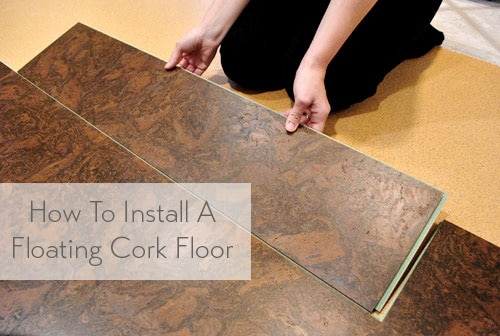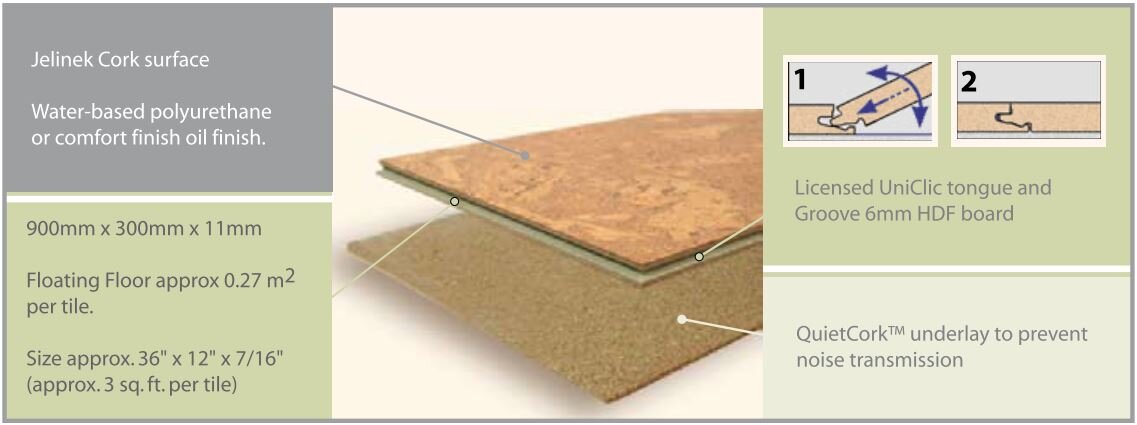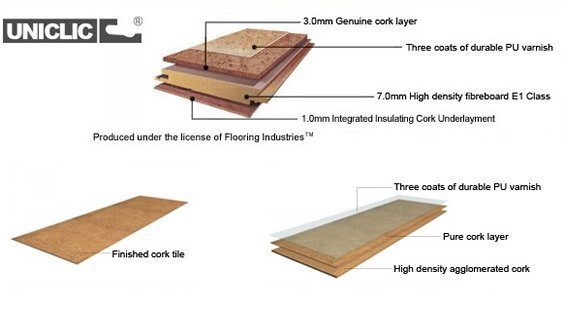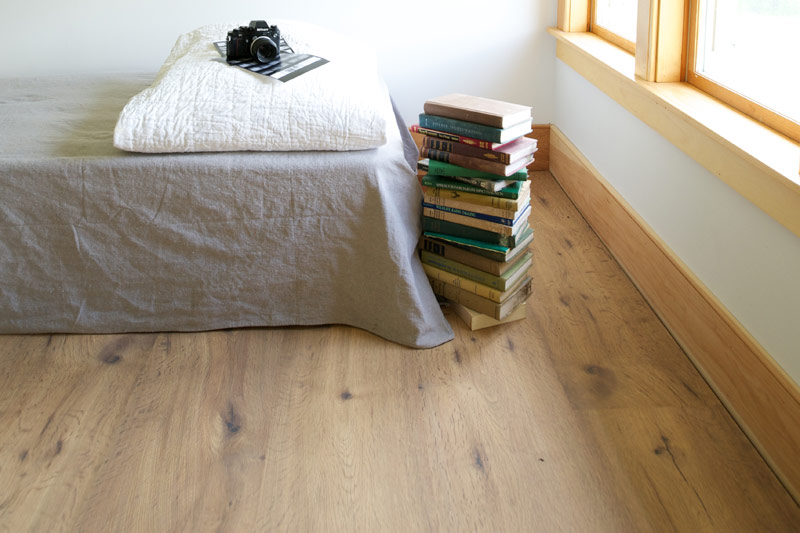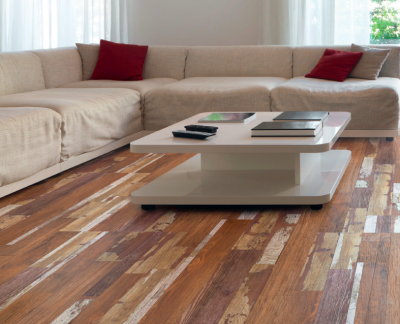Understanding Floating Cork Flooring
Floating cork flooring is a type of floor covering made from the bark of the cork oak tree. Unlike traditional cork flooring, which is glued down, floating cork flooring uses a click-and-lock mechanism that allows the planks to be installed without adhesive. This method makes it easy to install and provides several benefits that distinguish it from other flooring options.
- Eco-Friendly Material: Cork is a renewable resource harvested from the bark of the cork oak tree, which regenerates after the bark is stripped. This process makes cork one of the most sustainable flooring materials available. Choosing cork flooring supports responsible forestry practices and reduces the environmental impact of your home.
- Comfort and Resilience: Cork is naturally soft and resilient, making it comfortable underfoot. This property is especially beneficial in areas where you stand for long periods, like kitchens. The softness of cork also means it’s more forgiving if you drop something, reducing the risk of breakage or damage to fragile items.
- Thermal Insulation: One of the standout features of cork flooring is its excellent thermal insulation properties. Cork’s cellular structure contains millions of tiny air pockets that trap heat, making cork floors warm to the touch even in cooler climates. This natural insulation can help reduce heating costs and create a more comfortable living environment.
- Sound Absorption: Cork’s unique structure also makes it an effective sound insulator. It absorbs noise, reducing the transmission of sound between floors and creating a quieter home. This feature is particularly valuable in multi-level homes, apartments, or spaces where noise reduction is a priority.
- Durability: While cork is softer than hardwood, it is still durable and can withstand regular foot traffic. Floating cork flooring is designed to resist dents, scratches, and wear over time. With proper care and maintenance, cork floors can last for decades, providing a long-lasting flooring solution.
- Allergen Resistance: Cork flooring is naturally resistant to mold, mildew, and allergens, making it a great choice for households with allergy sufferers. The material’s anti-microbial properties help maintain a healthy indoor environment by preventing the growth of common allergens.

Benefits of Choosing Floating Cork Flooring
Floating cork flooring offers a wide range of benefits that make it an attractive option for homeowners. From sustainability to comfort, here are some of the key advantages of choosing cork flooring for your home.
Ease of Installation: One of the most significant benefits of floating cork flooring is the ease of installation. The click-and-lock system allows for a straightforward installation process that doesn’t require adhesives, nails, or staples. This means you can install the floor yourself with minimal tools and expertise, saving on installation costs.
Versatility: Floating cork flooring is versatile and can be installed over various subfloors, including concrete, wood, or existing flooring. This versatility makes it an excellent choice for remodeling projects, as it can be laid directly over most surfaces without the need for extensive preparation.
Comfort Underfoot: The natural resilience of cork provides a cushioned surface that’s comfortable to walk on. This makes cork flooring an ideal choice for areas where you spend a lot of time on your feet, such as kitchens or home offices. The slight give in the flooring also makes it easier on the joints, reducing fatigue.
Energy Efficiency: Cork’s natural thermal insulation properties help maintain a consistent temperature in your home, reducing the need for additional heating or cooling. This energy efficiency can lead to lower utility bills and a smaller carbon footprint, making cork flooring an environmentally responsible choice.
Low Maintenance: Cork flooring is relatively low maintenance compared to other flooring types. It doesn’t require regular waxing or polishing, and most spills can be wiped up with a damp cloth. Additionally, cork’s natural resistance to stains and water damage means it can be used in areas like kitchens or bathrooms with minimal upkeep.
Aesthetic Appeal: Cork flooring is available in a variety of colors, patterns, and finishes, allowing you to customize the look of your floors to match your home’s decor. Whether you prefer a natural wood-like appearance or a more contemporary design, cork flooring offers a range of options to suit your style.
Installation Process of Floating Cork Flooring
Installing floating cork flooring is a relatively simple process that can be completed by most DIY enthusiasts. However, following the correct steps is essential to ensure a flawless and long-lasting installation.
Preparation: Before you begin installing floating cork flooring, it’s crucial to prepare the subfloor. The surface must be clean, dry, and level to ensure the planks click together correctly. If the subfloor is uneven, consider using a self-leveling compound to create a smooth surface. Additionally, allow the cork planks to acclimate to the room’s temperature and humidity for at least 48 hours before installation.
Laying the Underlayment: An underlayment is necessary for floating cork flooring to provide a smooth surface and additional insulation. The underlayment also helps with sound absorption, further enhancing the cork’s natural noise-reducing properties. Roll out the underlayment across the entire floor area, ensuring it is flat and free of wrinkles.
Starting the Installation: Begin laying the cork planks along the longest wall in the room. Start in a corner and work your way out, using spacers to maintain an expansion gap around the room’s perimeter. This gap allows the floor to expand and contract with changes in temperature and humidity, preventing buckling or warping.
Click-and-Lock Mechanism: The planks are designed to click together with a tongue-and-groove system. Align the first plank’s tongue with the groove of the next plank and press down until you hear a click. This locking mechanism holds the planks securely in place without the need for glue or nails.
Cutting the Planks: You may need to cut some planks to fit around doorways, vents, or other obstacles. Use a fine-toothed saw or a jigsaw to make precise cuts. Ensure the cut edges are facing the wall, where they will be covered by baseboards or molding.
Finishing Touches: Once all the planks are installed, remove the spacers and install baseboards or molding around the room’s perimeter. This will cover the expansion gap and give the floor a finished look. Finally, clean the floor with a soft broom or vacuum to remove any dust or debris.
Design Options for Floating Cork Flooring
Floating cork flooring comes in a variety of designs, colors, and patterns, allowing you to create a custom look that suits your home’s aesthetic. Whether you prefer a natural appearance or something more modern, there’s a cork flooring option for every style.
Natural Cork: For those who love the organic look, natural cork flooring is an excellent choice. It showcases the natural grain and texture of cork, giving your floors a warm and earthy appearance. Natural cork flooring works well in spaces where you want to emphasize a connection to nature or create a cozy, inviting atmosphere.
Stained Cork: Stained cork flooring is available in a wide range of colors, from light neutrals to rich, dark tones. Staining allows you to customize the color of your cork floors to match your home’s decor. Whether you want a light, airy look or a dramatic, bold statement, stained cork provides the flexibility to achieve your desired aesthetic.
Patterned Cork: For a more unique and artistic look, patterned cork flooring is an option to consider. Patterns can range from subtle geometric designs to bold, intricate motifs. Patterned cork adds visual interest to a room and can serve as a focal point in your design. This option is perfect for spaces where you want to make a statement with your flooring.
Cork with a Wood-Look Finish: If you love the look of hardwood but want the benefits of cork, wood-look cork flooring is the ideal solution. These planks mimic the appearance of wood, complete with grain patterns and wood tones, but offer the comfort and sustainability of cork. Wood-look cork flooring is a great option for homeowners who want the aesthetic of wood without compromising on comfort or environmental impact.
Textured Cork: Textured cork flooring adds depth and dimension to your floors, creating a tactile experience underfoot. The texture can range from subtle embossing to more pronounced patterns that add a unique character to the room. Textured cork is an excellent choice for adding a layer of sophistication to your space while maintaining the practical benefits of cork flooring.
Cork Tiles: In addition to planks, cork flooring is also available in tiles. Cork tiles offer more flexibility in design, allowing you to create custom layouts or combine different colors and patterns. Tiles are particularly well-suited for smaller spaces or areas where you want to experiment with creative designs, such as bathrooms or entryways.
Maintaining and Caring for Floating Cork Flooring
Caring for floating cork flooring is straightforward, but it requires some specific practices to keep it looking its best. With the right maintenance routine, your cork floors can remain beautiful and functional for many years.
Regular Cleaning: Regular cleaning is essential to maintain the appearance of cork flooring. Use a soft broom or vacuum with a hardwood floor attachment to remove dirt and debris. Avoid using vacuums with beater bars, as they can damage the cork surface. For more thorough cleaning, use a damp mop with a pH-neutral cleaner designed for cork floors.
Protecting from Moisture: While cork is naturally resistant to water, excessive moisture can damage the flooring over time. Avoid using wet mops or excessive water when cleaning. In areas prone to spills, such as kitchens or bathrooms, consider placing mats or rugs to protect the floor. Wipe up spills immediately to prevent staining or water damage.
Preventing Scratches: Cork is more prone to scratches than harder flooring materials, so it’s important to take precautions. Use felt pads under furniture legs to prevent scratches when moving items across the floor. Additionally, avoid wearing high heels or shoes with sharp edges on cork flooring, as they can leave permanent marks.
Re-Sealing Cork Floors: Cork flooring may require re-sealing every few years to maintain its protective layer. The sealer helps protect the cork from moisture, stains, and wear. Use a high-quality sealer recommended by the manufacturer, and follow the application instructions carefully to ensure a long-lasting finish.
Handling Heavy Furniture: When moving heavy furniture or appliances, lift them rather than dragging them across the floor. Dragging heavy objects can cause scratches, dents, or even damage the click-and-lock mechanism of floating cork flooring. Consider using sliders or lifting straps to move heavy items safely.
Sunlight Exposure: Cork flooring can fade if exposed to direct sunlight for extended periods. To prevent fading, use window treatments like blinds or curtains to block UV rays. You can also rearrange furniture periodically to ensure even exposure to sunlight and minimize discoloration in specific areas.
Where to Use Floating Cork Flooring in Your Home
Floating cork flooring is versatile and can be used in various areas of your home. Its unique properties make it suitable for both practical and aesthetic applications in different spaces.
Living Rooms: The comfort and warmth of cork flooring make it an ideal choice for living rooms. It provides a cozy, inviting atmosphere that’s perfect for relaxation. The sound-absorbing properties of cork also help create a quieter environment, enhancing the comfort of your living space.
Kitchens: Cork’s resilience and comfort underfoot make it a great option for kitchens, where you spend a lot of time standing. Its natural thermal insulation keeps the floor warm, even during colder months, making it a pleasant surface to work on. Additionally, cork’s resistance to moisture makes it suitable for kitchen use, provided you clean up spills promptly.
Bedrooms: Cork flooring is an excellent choice for bedrooms due to its softness and warmth. It provides a cushioned surface that’s comfortable to walk barefoot, creating a cozy and comfortable environment. The natural insulation properties of cork also help maintain a consistent temperature in the bedroom, contributing to a restful night’s sleep.
Home Offices: In a home office, cork flooring can help create a productive and comfortable workspace. The sound-absorbing qualities of cork reduce noise, allowing for a quieter work environment. Additionally, the slight give in the flooring reduces fatigue, making it easier to spend long hours working at a desk.
Basements: Cork’s thermal insulation and moisture resistance make it a suitable choice for basements. It helps keep the space warm and comfortable, even in cooler climates. However, it’s essential to ensure that the basement is dry and free of moisture issues before installing cork flooring, as excessive moisture can damage the material.
Playrooms: The soft, cushioned surface of cork flooring is ideal for playrooms, where children spend time playing on the floor. Cork provides a comfortable and safe surface that reduces the risk of injuries from falls. Its durability also makes it a practical choice for areas that experience heavy foot traffic and activity.
Common Mistakes to Avoid
When installing floating cork flooring, there are a few common mistakes that can impact the performance and longevity of your floor. By being aware of these pitfalls, you can ensure a successful installation and a floor that lasts for years.
Ignoring Subfloor Preparation: A smooth, level subfloor is crucial for the proper installation of floating cork flooring. Skipping this step can result in an uneven floor, gaps between planks, and potential damage to the click-and-lock mechanism. Always take the time to prepare the subfloor correctly before installation.
Skipping the Acclimation Period: Cork planks need time to acclimate to the room’s temperature and humidity before installation. Failing to allow this acclimation period can lead to expansion or contraction issues after the floor is installed, resulting in gaps or buckling.
Not Using an Underlayment: An underlayment is essential for floating cork flooring, providing additional insulation, sound absorption, and a smooth surface for the planks to rest on. Skipping the underlayment can lead to noise issues, reduced comfort, and potential damage to the floor over time.
Improper Cutting of Planks: Precision is key when cutting cork planks to fit around obstacles. Poorly cut planks can result in gaps or uneven edges that detract from the appearance of the floor. Use the right tools and take your time to make accurate cuts.
Failing to Leave an Expansion Gap: Cork flooring expands and contracts with changes in temperature and humidity. Failing to leave an expansion gap around the room’s perimeter can cause the floor to buckle or warp over time. Always use spacers to ensure a consistent expansion gap during installation.
Using Harsh Cleaners: Cork flooring requires specific care to maintain its appearance and durability. Using harsh or abrasive cleaners can damage the cork surface, leading to discoloration or wear. Stick to pH-neutral cleaners designed for cork flooring to avoid damaging the material.
What are the benefits of floating cork flooring over traditional cork flooring?
Floating cork flooring offers several advantages over traditional glue-down cork flooring. The click-and-lock installation system makes it easier to install, especially for DIY enthusiasts, and eliminates the need for adhesives, which can be messy and time-consuming. Floating cork flooring is also more versatile, as it can be installed over various subfloors without extensive preparation. Additionally, it’s easier to repair or replace individual planks if needed, making it a more practical option for many homeowners.
Can floating cork flooring be installed in bathrooms or kitchens?
Yes, floating cork flooring can be installed in both bathrooms and kitchens, provided proper precautions are taken. Cork is naturally resistant to moisture, but it’s important to seal the flooring to prevent water damage. In bathrooms, where water exposure is more likely, additional measures such as using mats or rugs near water sources and promptly cleaning up spills can help protect the floor. In kitchens, cork’s comfort underfoot and resilience make it an ideal choice, but sealing and maintenance are essential to ensure its longevity.
How does cork flooring compare to hardwood in terms of durability?
While cork flooring is softer than hardwood, it is still quite durable and capable of withstanding regular foot traffic. Cork’s resilience allows it to bounce back from minor impacts, reducing the risk of dents. However, cork is more susceptible to scratches than hardwood, so it’s important to take precautions such as using felt pads under furniture and avoiding sharp objects on the floor. With proper care, cork flooring can last for decades, making it a durable and eco-friendly alternative to hardwood.
Is cork flooring a good choice for homes with pets?
Cork flooring can be a good choice for homes with pets, as it is naturally resistant to mold, mildew, and allergens, which can benefit both pets and their owners. However, because cork is softer than other flooring materials, it is more prone to scratches from pet claws. Regular nail trimming and using rugs or mats in high-traffic areas can help protect the cork surface. Cork’s softness also makes it comfortable for pets to walk or lie on, adding to the overall comfort of your home.
How should I maintain and clean floating cork flooring?
Maintaining and cleaning floating cork flooring is relatively simple. Regularly sweep or vacuum the floor to remove dirt and debris, and use a damp mop with a pH-neutral cleaner for more thorough cleaning. Avoid using wet mops, harsh chemicals, or abrasive tools, as they can damage the cork surface. It’s also important to re-seal the flooring every few years to protect it from moisture and wear. With proper care, cork flooring can remain beautiful and functional for many years.
Can I refinish cork flooring if it becomes worn or damaged?
Yes, cork flooring can be refinished if it becomes worn or damaged. However, refinishing cork is more challenging than refinishing hardwood, as it requires sanding down the cork surface, which is thinner than wood. If the cork is thick enough, a professional can sand and re-seal the floor to restore its appearance. For minor scratches or wear, using a cork repair kit may be sufficient. Regular maintenance and careful use can help minimize the need for refinishing.
One possibility is a cork floor, but what is cork?
Floating Floor and Cork Planks by WE Cork
Floating Cork Flooring WE Cork
Floating Cork FLooring Benefits With Uniclic System – ICork Floor
Related Posts:
